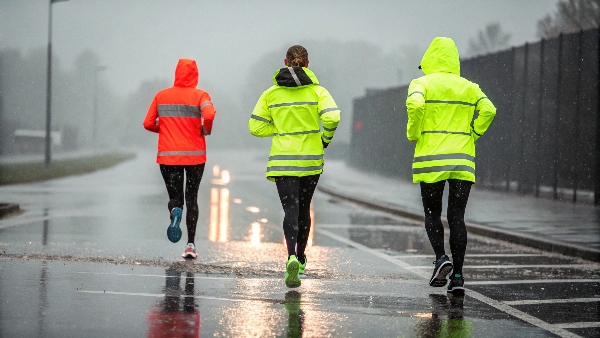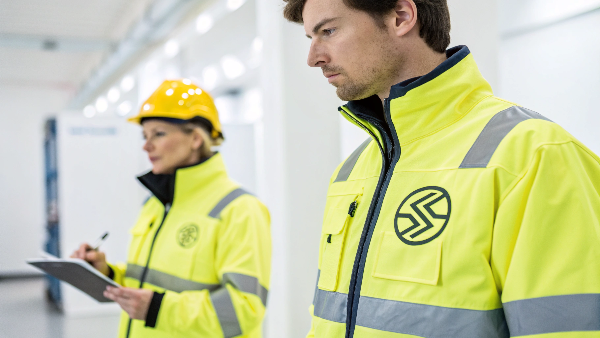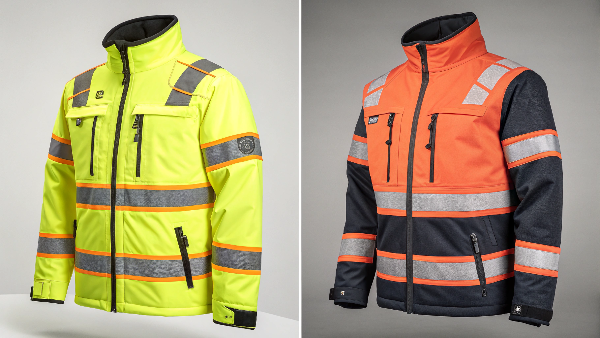Dark nights hide dangers. Worried about not being seen? Reflective gear boosts visibility, keeping you safe.
Wearing reflective clothing at night greatly improves your visibility to drivers. These materials reflect light back, making you stand out and preventing accidents in low-light conditions.
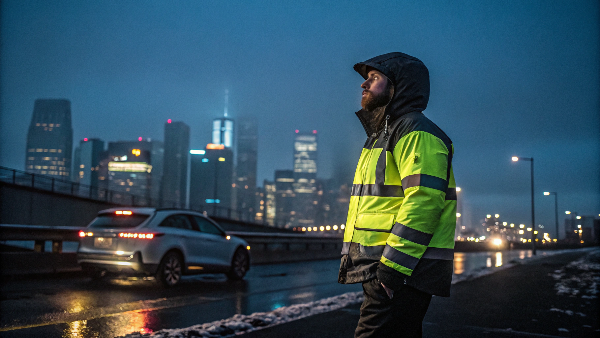
It's clear that being seen at night is vital. But let's explore this further. We need to understand exactly why this simple choice can be a lifesaver. Many people wonder about the specifics of how it all works. Let's dive into some common questions.
Why is it important to wear reflective clothing1 at night?
Nighttime activities can be risky. Unseen pedestrians face danger. Reflective clothing offers a simple, effective solution.
It's crucial because it makes you significantly more visible to motorists in the dark. This greatly reduces accident risks, especially on poorly lit roads or work sites.

The main reason it's so important is accident prevention2. Think about it. When it's dark, a driver's ability to see you is much lower. Statistics often show a spike in accidents involving pedestrians or cyclists during nighttime hours. Human vision just isn't designed for perfect clarity in low light. Reflective clothing works by creating a strong contrast. You stand out against the dark background when a car's headlights hit the material.
My experience with Vissafetywear really brings this home. We've seen firsthand how our products directly contribute to safety. For instance, Danny Cheng, one of our valued long-term clients from California, always stresses the importance of ANSI/ISEA 107 compliance3 for his market. He serves industries like construction and logistics. Danny knows this standard ensures maximum visibility for workers. He once shared a story about a near-miss one of his clients experienced. Their Vissafety vest made all the difference in that critical moment. This isn't just about meeting standards for us. It's about saving lives. Our commitment at Vissafetywear, a company established in 2007, is to produce top-quality high-visibility clothing that people can trust, day or night.
Why is reflective clothing important?
Visibility is key to safety. Many overlook this simple protection. Reflective clothing ensures you are seen by others.
Reflective clothing is important because it drastically increases how well others see you in dim light. This is vital for preventing accidents for anyone outdoors.
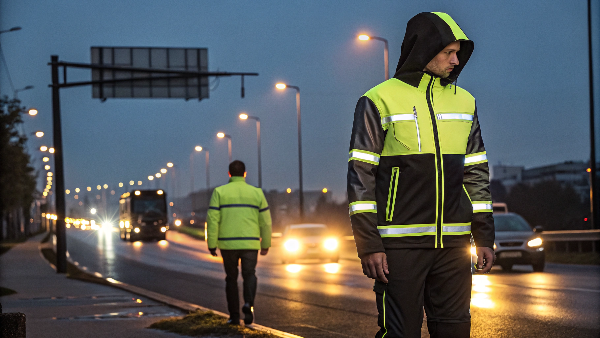
Reflective clothing isn't just for the dead of night. Its importance extends to any low-visibility condition. This includes dawn, dusk, foggy days, or even during heavy rain. The core function is to make you stand out when you might otherwise blend into the surroundings.
The Science of Being Seen
This isn't just about shiny fabric. Reflective materials use a clever technology called retroreflection4. This means they don't just scatter light; they bounce it directly back towards the original light source, like a car's headlights.
| Feature | Description | Benefit |
|---|---|---|
| Retroreflection | Bounces light directly back to its source (e.g., car headlights) | Makes wearer appear brightly illuminated |
| Contrast | Creates a stark difference between the wearer and the dark background | Catches the eye of drivers much sooner |
| Versatility | Used in various garments: vests, jackets, trousers, even accessories | Adaptable to different needs and professions |
At Vissafetywear, we are a manufacturer of high visibility clothing5, and we incorporate high-quality reflective tapes that meet global standards. These include EN ISO 20471 for Europe and ANSI/ISEA 107 for the US. Danny Cheng often tells me how critical these certifications are for his business. It gives his clients in North America peace of mind. They know they're getting products they can truly rely on for safety. It’s not just about putting some shiny tape on a garment. It's about the science of visibility and the careful engineering behind effective safety apparel. Our R&D lab, with its 75+ testing devices, ensures this.
What is reflective material at night?
Ever wonder how some clothes shine so brightly in headlights? It's not magic. Special materials make you highly visible to oncoming traffic.
Reflective material at night uses tiny glass beads or micro-prisms. These elements bounce light directly back to its source, like car headlights, making you appear very bright.
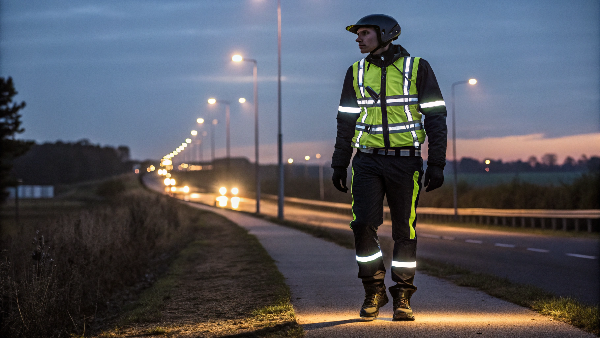
Let's look deeper into how these materials work. It's all about something called retroreflection6. Imagine throwing a ball against a flat wall; it bounces off at an angle. Retroreflective materials are different. They send light directly back to where it came from.
How Reflective Materials Work
There are a couple of main types of reflective materials used in safety clothing:
- Glass Bead Technology7: These materials have millions of tiny, microscopic glass spheres. When light from, say, a car's headlight, enters one of these beads, it hits a mirrored surface at the back of the bead. Then, it reflects and is directed right back to the car and the driver's eyes.
- Prismatic Technology: This type uses micro-prisms. These are tiny, precise angled surfaces. They work in a similar way to glass beads by redirecting light back to its origin. Prismatic materials can sometimes be more efficient and even more durable under harsh conditions.
When I first visited the Vissafetywear factory in China, I was truly fascinated by their R&D laboratory. It’s an industry-leading facility. They have over 75 different testing devices just to ensure the reflective materials8 meet exact specifications for brightness, durability, and colorfastness. This dedication to quality control, including triple inspections (pre-production, in-process, and final), is why we can confidently say our high-visibility clothing works effectively, night after night. We often discuss new material innovations with clients like Danny Cheng. This helps ensure the products he imports to California remain cutting-edge and offer the best protection.
Why should we wear light Coloured clothes at night?
Dark clothes blend in with shadows. This makes you almost invisible to drivers. Light colors offer better contrast, but is that enough on its own?
Light-colored clothes are better than dark ones at night as they reflect more ambient light. However, for true nighttime visibility against headlights, reflective materials are far superior.

It's true that wearing light-colored clothing, like white or yellow, is generally better than wearing dark colors, such as black or navy blue, at night. Light colors reflect more of the available ambient light. This means if there are streetlights or moonlight, you'll be a bit more noticeable. However, this relies entirely on there being enough ambient light. On a very dark road with no streetlights, even a white shirt won't make you stand out much to a driver.
Light Colors vs. Reflective Materials
The key difference is how they interact with light. Light-colored clothing passively reflects whatever ambient light is around. Reflective materials, on the other hand, are designed to actively bounce back directed light, specifically the kind that comes from a vehicle's headlights. This makes them vastly more effective for being seen by drivers.
| Clothing Type | Visibility in Low Ambient Light | Visibility with Headlights | Best Use Case |
|---|---|---|---|
| Dark Colors | Poor | Poor | Not recommended for nighttime visibility |
| Light Colors | Fair | Fair to Good | Better than dark, but not ideal for safety |
| Reflective Clothing | Poor (without light source) | Excellent | Essential for nighttime safety |
At Vissafetywear, we often produce garments that combine both. Many of our high-visibility items come in fluorescent, bright colors like yellow, orange, or lime green. These fluorescent colors are excellent for daytime visibility, as they react with UV rays from the sun to appear brighter. Then, we add high-quality reflective tapes to these garments. This provides the crucial nighttime visibility when hit by headlights. Danny’s clients, particularly in the construction and logistics sectors, really appreciate this dual benefit. Their workers often operate in varying light conditions throughout their shifts, from bright daylight to complete darkness. Our mission is to provide top-quality, stylish, and customizable High Visibility Clothing, and this combination is a perfect example.
Does reflective clothing glow in the dark?
Some materials seem to shine on their own in the dark. People sometimes ask if reflective clothing is one of them. Let's clarify this common question.
No, reflective clothing doesn't glow in the dark by itself. It needs an external light source, like car headlights, to shine back brightly towards that source.

It's important to understand the difference between "reflective" and "photoluminescent" (which is true glow-in-the-dark). They work in very different ways.
Reflective vs. Photoluminescent
- Reflective Materials: These work by retroreflection, as we've discussed. They require an external light source, such as a car's headlights or a flashlight, to be directed at them. The material then bounces that light directly back to the source. So, if you're wearing a reflective vest and a car approaches, the driver will see your vest light up brightly because their headlights are shining on it and the light is returning to their eyes. Without that external light, the reflective material won't appear to shine.
- Photoluminescent Materials (Glow-in-the-Dark): These materials absorb light energy from a source like sunlight or strong artificial light. They store this energy and then slowly release it as a visible glow. This glow can last for some time, even after the initial light source is removed. Think of glow-in-the-dark stars on a ceiling. They "charge up" during the day and then glow at night.
Reflective clothing is specifically designed for active visibility in situations where there will be light sources, particularly vehicle headlights. This is absolutely crucial for roadside safety and for workers in industrial environments where vehicle traffic is common. While photoluminescent materials have their uses, for the kind of high-impact, life-saving visibility that Danny Cheng’s clients in construction and logistics demand, retroreflection is the industry standard and the most reliable technology. At Vissafetywear, our focus is on using high-grade retroreflective materials. We ensure these reflective elements are strategically placed on garments for maximum 360-degree visibility, following guidelines from standards like EN ISO 20471 and ANSI/ISEA 107.
Who wears reflective clothing?
You might think reflective gear is just for construction crews or emergency responders. But many different people benefit from its protection. You might be surprised by who needs it.
Many people wear reflective clothing: construction workers, road crews, emergency responders, cyclists, runners, and even children walking to school in dim light.
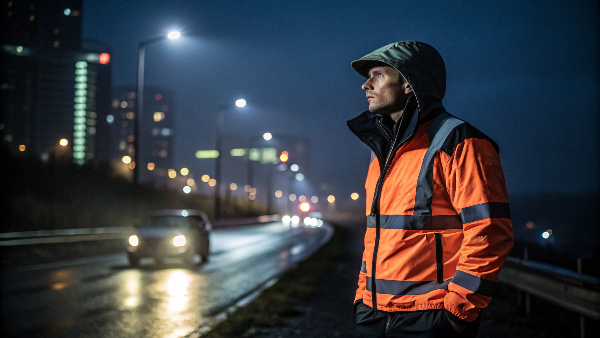
The range of individuals and professions that rely on reflective clothing is broad. This really highlights its versatility and the universal importance of being seen in low-light conditions.
Diverse Users of Reflective Gear
Here’s a breakdown of some common users:
- Occupational Users: This is a major category.
- Construction workers (like many of Danny Cheng’s clients in North America)
- Road maintenance crews
- Emergency services personnel (police officers, firefighters, paramedics)
- Airport ground staff (baggage handlers, tarmac workers)
- Logistics and warehouse personnel, especially those working around forklifts or delivery vehicles
- Utility workers
- Railway workers
- Recreational Users: Safety is important during leisure time too.
- Cyclists, especially commuters or those riding at dawn, dusk, or night
- Runners and joggers
- Walkers and hikers, particularly when out early or late
- Motorcyclists and scooter riders
- Horseback riders
- Everyday Users:
- Children walking or biking to and from school, especially in winter months
- Anyone walking their dog in the evening
- People whose cars break down and need to be visible on the roadside
Vissafetywear is a B2B and wholesale-only business. We cater extensively to large corporate buyers and brands & distributors like Danny’s company. He supplies high-visibility safety apparel to demanding sectors. Our ability to customize – from reflective tapes, logos, and colors to specific sizes, packaging, and even developing rare styles – means we can provide tailored solutions for many different professions and needs. Danny often requires unique designs for his North American market, and our R&D team works closely with him to develop products that meet those exact requirements while fully complying with all necessary safety standards. This collaborative approach ensures the end-users get the best possible protection.
What is an example of reflective clothing?
If you're unsure what exactly counts as reflective clothing, it's more than just the classic safety vest. Many different types of garments incorporate this life-saving feature.
Examples include safety vests, jackets with reflective stripes, trousers with reflective tape around the legs, full-body coveralls, and even accessories like hats or armbands with reflective elements.

The most recognizable piece of reflective clothing is probably the high-visibility safety vest, often seen in bright yellow or orange with silver stripes. But the range of garments that can incorporate reflective materials is much wider, designed for various climates, job functions, and activities.
Common Types of Reflective Garments
Here are some key examples:
- Safety Vests: These are lightweight and designed to be worn over other clothing. They come in various styles and classes based on the amount of background material and reflective tape, like those meeting ANSI Class 2 or Class 3.
- Jackets: For cooler weather or outdoor work, jackets can have reflective patterns on the torso, sleeves, and back for 360-degree visibility. This includes bomber jackets, parkas, and softshells.
- Trousers/Pants: These often feature reflective bands around the lower legs or stripes down the sides, crucial for being seen from lower angles.
- Coveralls: Offering full-body protection, coveralls used in industries like oil & gas or heavy manufacturing often have extensive reflective detailing.
- Rainwear: Waterproof jackets and trousers can also be high-visibility, incorporating reflective elements to ensure workers are seen even in poor weather.
- Shirts/Polos: For warmer conditions or as a base layer, long and short-sleeved shirts and polos can have reflective stripes.
- Accessories: Smaller items also play a role:
- Armbands and leg bands
- Hats (beanies, caps) with reflective trim
- Gloves with reflective backing
- Backpack covers for cyclists or students
Our Vissafetywear product range is extensive, covering all these core product categories. We pride ourselves on offering customizable options, including unique selling points like rare styles and eco-friendly materials. A great example of our collaborative innovation is the 2023 project with Danny Cheng where we co-designed detachable-reflective-strip work pants. This design enhanced functionality for the wearers and helped reduce replacement costs for Danny's clients, demonstrating how we tailor products to specific market needs and pain points. It’s this kind of focus on client requirements and product innovation, backed by our 200,000 sqm self-owned factory and 20+ advanced production lines, that sets Vissafetywear apart.
Why do I see glare when driving at night?
Night driving can be tough on the eyes. That annoying glare from other lights can make it even worse. Understanding what causes it can help you appreciate why being highly visible is so important.
Glare at night is often from oncoming headlights, streetlights, or reflections off wet surfaces. This excess light scatters, reducing your ability to see clearly and distinguish objects.
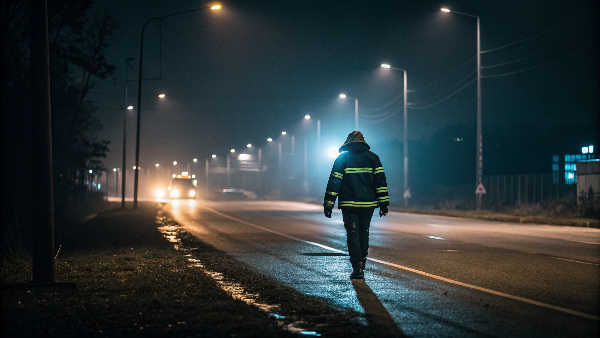
Glare is a common and frustrating problem for drivers, especially at night. It's essentially a visual sensation caused by excessive and uncontrolled brightness within your field of vision. This can significantly impair your ability to see the road and potential hazards clearly.
Understanding Nighttime Glare
Several factors contribute to nighttime glare9:
- Sources of Glare:
- Oncoming Headlights: This is the most common culprit. Modern headlights, especially very bright LEDs or HIDs, can be intense. If they are poorly aligned, the problem is even worse.
- Streetlights: While helpful for illumination, badly designed or overly bright streetlights can also contribute to glare.
- Reflections: Light reflecting off wet roads, puddles, or even road signs can create distracting glare.
- Your Own Windshield: A dirty, smudged, or scratched windshield (both inside and out) can scatter light and significantly worsen the effects of glare.
- Impact on Vision:
- Reduced Contrast: Glare makes it harder to distinguish objects from their background, especially darker objects like pedestrians not wearing reflective gear.
- Temporary "Blindness": A bright flash of glare can cause momentary loss of detailed vision as your eyes struggle to adapt.
- Discomfort and Eye Strain: Prolonged exposure to glare can lead to eye fatigue, headaches, and general discomfort while driving.
- Slower Reaction Times: If you can't see clearly due to glare, your ability to react quickly to hazards is compromised.
This issue of driver glare is precisely why high-quality reflective clothing is so vital for anyone who might be near roads at night. While glare is a problem for the driver, well-designed reflective clothing on a pedestrian or worker uses the car's headlight beams to become intensely visible. It provides a clear, bright signal that cuts through the visual "noise" of other lights and reflections. This allows the driver to identify a person much sooner, even amidst other sources of glare. Our focus at Vissafetywear, with our triple inspection quality assurance and adherence to global standards like EN ISO 20471 and ANSI/ISEA 107, is to make wearers as conspicuous as possible. This helps to counteract the challenges drivers face with nighttime glare and ultimately improves safety for everyone.
Conclusion
Reflective clothing is vital for nighttime safety. It makes you seen, prevents accidents, and protects lives. Choose Vissafetywear for quality, innovation, and reliability.
-
Explore how reflective clothing enhances visibility and safety during nighttime activities, reducing accident risks significantly. ↩
-
Discover the impact of reflective clothing on accident prevention and how it can save lives during nighttime activities. ↩
-
Learn about ANSI/ISEA 107 compliance standards and their role in ensuring maximum visibility and safety for workers in various industries. ↩
-
Learn about retroreflection technology and its role in improving visibility, making it essential for safety gear in low-light conditions. ↩
-
Discover the global standards for high visibility clothing to ensure safety and compliance in various environments, vital for workers and outdoor enthusiasts. ↩
-
Understanding retroreflection can help you appreciate the science behind visibility in safety gear, making it essential for safety professionals. ↩
-
Learn about Glass Bead Technology to see how it enhances safety clothing, ensuring you stay visible in dark conditions. ↩
-
Explore how reflective materials enhance safety and visibility, crucial for anyone working in low-light conditions. ↩
-
Understanding the causes of nighttime glare can help improve your driving safety and comfort. Explore this resource for insights. ↩

